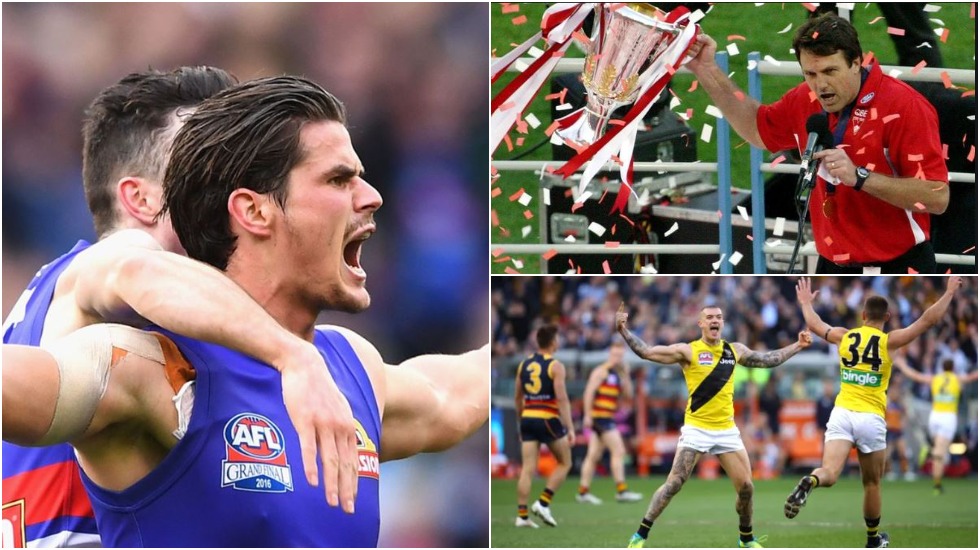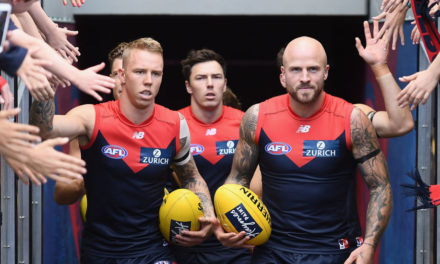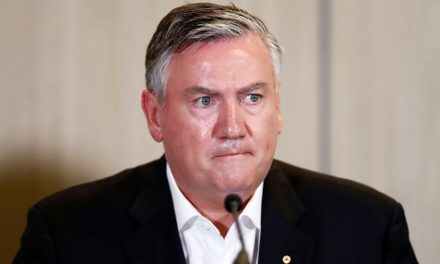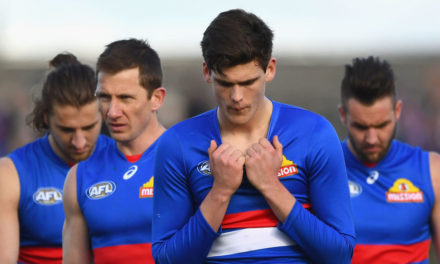Famous premiership droughts broken (clockwise from left): Western Bulldogs in 2016, Sydney in 2005, Richmond in 2017.
Port Adelaide intends to win three of the next five AFL premierships. At least it has left two for everyone else in the 18-team national league.
The 19th century club that has dubbed itself the “greatest in Australian football” – based on 37 titles across the SANFL and AFL, including six-in-a-row in the South Australian league from 1954-1959 – is amid its longest drought … in any competition.
There has been no national crown since the breakthrough AFL premiership in 2004 and no monopoly on the South Australian title since 1999 – 16 years with no champagne at Alberton, overshadowing the record 12-year gap between 1965 and 1977.
There is the telling tale from Amanda Vanstone’s entry to the Port Adelaide board room in 2014, when she arrived at Alberton Oval for her first directors’ meeting dragging a shopping trolley. She grabbed from its pouch a full carton of beer produced as commemorative cans to celebrate the 2004 AFL flag – and declared that after 10 years it was time for a new slab to celebrate a new premiership.
Vanstone left the Port Adelaide board last year with her thirst for premiership success – let alone beer – never sated. The drought goes on … even at a club that declares it “exists to win premierships”.
Thirty years have passed since the VFL rebadged its premiership trophy with the AFL (Australian Football League) logo. And that first “national” title ended the most-lampooned premiership drought of the last chapter of VFL suburban football – Collingwood’s 32-year “Colliwobbles” run from 1958-1990.
In the three decades of national crowns (which some try to suggest should mark the true count of any AFL premiership tally), four other significant droughts have ended:
2005: SYDNEY went 72 years without uncorking champagne bottles – and two decades earlier had moved its home from the Lake Oval of suburban Melbourne to Australia’s biggest city on Sydney’s harbour. It was the South Melbourne Football Club in winning the 1933 VFL title. This 72-year gap remains the longest premiership drought in VFL-AFL. But this dubious record could fall in the next two decades considering the challenge to win a flag has come to exhaust and crush quite a few clubs, new and old.
2007: GEELONG endured its longest premiership drought – 44 years – and grand final pain in 1967, 1989, 1992, 1994 and 1995 before coach Mark Thompson changed his victory speech on the MCG stage while collecting a flag that is marked by the biggest win (119 points against Port Adelaide) in VFL-AFL grand final records. Tempted to mirror Mark Williams’ “you were wrong” sledge from 2004, Thompson binned his long-brewed crack at the review he endured at Kardinia Park in 2006 on observing the tear-dripping reaction of life-long Geelong supporters. The Essendon hero realised he could not make such a moment about him, more so when elderly Geelong supporters told him they could now “die with a smile” on their previously tormented faces. Sometimes, football is indeed life and death.
2016: FOOTSCRAY, now the Western Bulldogs, ended a 55-year grand final drought by rising from seventh to the premiership play-off against Sydney at the MCG on October 1. And with this remarkable opportunity, Luke Beveridge’s ambitious soldiers ended a 62-year sequence of having the 1954 VFL premiership trophy sit alone at the Western Oval. Those 62 years without a flag and 55 years between grand finals did build up emotions.
2017: RICHMOND brushed aside all the well-worn cracks of being the best-ever ninth-ranked team in football history by clearing away a much-mocked 37-year premiership drought – and has since replaced scorn with admiration by following up with consecutive titles in 2019-2020. That “yellow and black” chorus just echoes and echoes.
In a century when Major League Baseball lost two of its greatest curses – with the Boston Red Sox overcoming 85 years of misery (1918-2004) and the Chicago Cubs ending the longest gap between World Series crowns, 107 years (1908-2016), our own NRL saw the South Sydney Rabbitohs brush aside a 43-year gap between titles (1971-2014), and in English soccer, Liverpool had to work through the threat of the COVID pandemic to end its 30-year title drought.
But the AFL certainly has not disappointed with its own success stories that captured the attention and emotions of “neutral” fans.
Which was the greatest celebration of hard-earned success? Collingwood in 1990, Geelong in 2007, Sydney, with coach Paul Roos’ yelling: “Here it is!” in 2005, or the Western Bulldogs in 2016, with injured captain and the team’s spiritual commander, Bob Murphy, rightfully called to the stage to collect the premiership trophy? Or the seemingly never-ending Richmond parade?
So, on the oft-repeated premise that only one team can win the AFL premiership in any season – and with Port Adelaide having made claims to three of the next five – which current drought would create the greatest reaction across Australian football’s fan base?
If your club could not win the 2021 flag, which team would you not begrudge a night of champagne in late September (or mid-October if the pandemic creates fixture havoc again)?
Melbourne? No premiership since Norm Smith ruled in 1964 – now 56 years with two grand final defeats (1988 and 2000).
St Kilda? That lone premiership of 1966 – won with the most successful miss at goal by Barry Breen – ended a 69-year drought. Now it is 55 years of chasing a second title with four grand final losses (1971, 1997, 2009 and that replay in 2010 with Collingwood).
Melbourne and St Kilda are the only old-league VFL clubs without a premiership trophy (other than those night/pre-season titles that filled St Kilda coach Grant Thomas with such “joy”) in their cabinets carrying the distinctive AFL logo. Even VFL founding club Fitzroy managed to find an end to its drought (from 1944) by taking its Lions motif to Brisbane.
PLEASE HELP US CONTINUE TO THRIVE BY BECOMING AN OFFICIAL FOOTYOLOGY PATRON. JUST CLICK THIS LINK.
Which premiership party would draw the most hanger-ons? Which club song would be learned in record numbers and with fast pace? Which victory speech would resonate beyond a long-suffering supporter group?
How would Titus O’Reily reinvent himself if his stand-up act and Twitter feed could no longer rely on the disappointment of failed promises and misguided hope at Melbourne?
Barry Breen will have his wish, to be guaranteed an end to the predictable telephone call each time St Kilda qualifies for a grand final, asking him to recount the most famous behind in Australian football. (The most effective miskick ever, Champion Data statisticians please note).
Hall of Famer Robert Walls knows of the significance of a drought-breaking premiership when compared to any other flag. He was an 18-year-old star in the making when he played his part in ending Carlton’s 21-year drought with a three-point win against Essendon in the 1968 VFL grand final – a triumph engineered by the man Norm Smith had hoped would continue a dynasty at Melbourne, Ron Barassi.
“Three years earlier, as a 15-year-old, I am barracking madly for Essendon (in the 1965) grand final (win against St Kilda), and in 1968 I am in a back-pocket playing against Essendon for a premiership,” Walls recalled this week for Footyology.
“The Carlton social club had opened that year (1968) – and it was a big deal, too. Ronald Dale Barassi had called us back to the club after that grand final – and it is where I learned what a premiership means. As a kid, it hit home just how important a flag is to supporters, more so when they have not celebrated a premiership for such a long, long time.
“As a kid starting out in football, you think of yourself, your teammates, but that night, looking at the faces of those Carlton fans, seeing the joy they had after 21 years, you knew playing football and winning flags was much more than what you or your teammates felt or wanted in football.”
So which drought-breaking premiership would create the greatest euphoria, Melbourne or St Kilda? And not just for the winning team’s supporter base?
“Both fan bases have done it so hard for so long,” says Walls. “Melbourne since 1964, St Kilda since 1966 … but it feels as if St Kilda have had more moments of opportunity than Melbourne. So I would say a Melbourne premiership would drive more passion.
“There is an underlying group of Melbourne supporters who have been down for years and years. They have been belted. Remember, this is the club that has all the history and tradition, and in the 1950s, when I was growing up, Melbourne was THE team. Smith, Barassi, all the big names in footy and premierships, one after the other.
“There are many ‘old money’ people who would come out of the woodwork if Melbourne won a flag after such a long drought.”
Darryl Wakelin says the same of the St Kilda supporter base. He played in St Kilda’s 1997 AFL grand final loss to Adelaide; he stopped St Kilda in the epic 2004 preliminary final at Football Park when holding up the Port Adelaide defence at full back against Fraser Gehrig.
“It would be an incredible, amazing moment for St Kilda’s supporters,” says Wakelin, a 115-game Saint.
“You need to appreciate how the St Kilda Football Club is connected to a massive supporter base along the Mornington Peninsula. If you live in Bayside, you ride the St Kilda wave. They have not had success, but they are strongly connected to their football club. A premiership would be massive for them.
“Melbourne has a different culture, one I don’t understand. But I can appreciate how a premiership would be incredible for both clubs. We saw that with the Western Bulldogs in 2016. They had everyone except the Sydney supporters barracking for them to end their drought – how amazing was that day? And made more special with Luke Beveridge as a former player being their premiership coach.
“Imagine the joy people in football would take from watching Brett Ratten, a pretty special guy, coach St Kilda to its second premiership?”
St Kilda and Melbourne are Australian football’s version of the Red Sox and Cubs from American baseball. And then there are the modern AFL-era droughts that carry their own emotional scripts for diverse supporter clans.
CARLTON is amid its longest wait for a flag – now 25 years since the 1995 triumph against Geelong. And no grand final since 1999 while the rebuild goes on and on.
ADELAIDE has reached 22 years with its fans needing to find the best washing detergent to protect the colours on those commemorative T-shirts that marked the back-to-back flags of 1997-1998 delivered by the “Messiah” Malcolm Blight.
ESSENDON, starting to resemble Melbourne for disappointment after Smith left Australia’s oldest football club – has not won a premiership since Kevin Sheedy almost completed the invincible season in 2000. And what is that statistic about Essendon’s winning rate in September since 2005? One win in 12 games, eight of which were finals, and no consecutive wins in finals since reaching the 2001 AFL grand final against Brisbane.
FREMANTLE has no title from 26 years of AFL competition – and might just have an AFLW trophy in its clubhouse before an AFL crown.
That prediction from master recruiter Matt Rendell that the most-recent expansion clubs, Greater Western Sydney and Gold Coast, were to dominate the AFL – with “10 flags-in-a-row between 2015-2025” – is now a false prophecy.
In those 30 years since the VFL logo was replaced by the AFL motif on the premiership trophy, the 31 crowns have been spread across 13 of 18 clubs –
FIVE – Hawthorn (1991, 2008, 2013, 2014 and 2015).
FOUR – West Coast (1992, 1994, 2006 and 2018).
THREE – Brisbane (2001, 2002 and 2003); Geelong (2007, 2009 and 2011); and Richmond (2017, 2019 and 2020).
TWO – Adelaide (1997 and 1998); Collingwood (1990 and 2010); Essendon (1993 and 2000); North Melbourne (1996 and 1999); and Sydney (2005 and 2012).
ONE – Carlton (1995); Port Adelaide (2004); and Western Bulldogs (2016).
But a new season starts with new hope for all.













Is there a reason that North Melbourne has been ignored in this article? You’ve listed 4 clubs towards the end, one who has won a flag more recently than North.